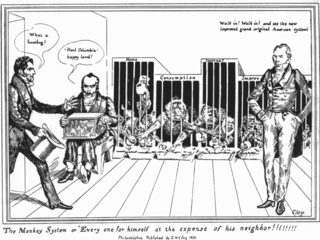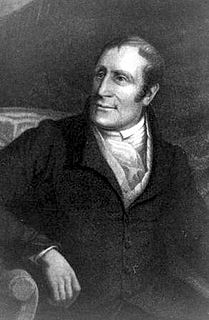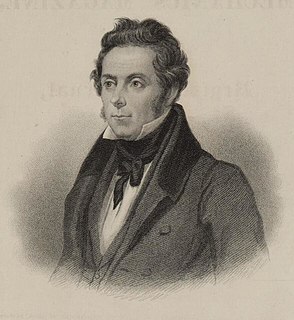
Sir John Benjamin Macneill FRS was an eminent Irish civil engineer of the 19th century, closely associated with Thomas Telford. His most notable projects were railway schemes in Ireland.
The Bolton and Leigh Railway (B&LR) was the first public railway in Lancashire, it opened for goods on 1 August 1828 preceding the Liverpool and Manchester Railway (L&MR) by two years. Passengers were carried from 1831. The railway operated independently until 1845 when it became part of the Grand Junction Railway.

This is a list of the earliest railroads in North America, including various railroad-like precursors to the general modern form of a company or government agency operating locomotive-drawn trains on metal tracks.

Henry Brooke Parnell, 1st Baron Congleton PC, known as Sir Henry Parnell, Bt, from 1812 to 1841, was an Irish writer and Whig politician. He was a member of the Whig administrations headed by Lord Grey and Lord Melbourne of the 1830s and also published works on financial and penal questions as well as on civil engineering. He was the great-uncle of Irish nationalist leader Charles Stewart Parnell.
Hamilton Fulton was a Scottish civil engineer who worked for John Rennie and Thomas Telford before moving for a decade to the state of North Carolina as its principal engineer. Thereafter, he returned to Britain.

The American System was an economic plan that played an important role in American policy during the first half of the 19th century. Rooted in the "American School" ideas of Alexander Hamilton, the plan "consisted of three mutually reinforcing parts: a tariff to protect and promote American industry; a national bank to foster commerce; and federal subsidies for roads, canals, and other 'internal improvements' to develop profitable markets for agriculture". Congressman Henry Clay was the plan's foremost proponent and the first to refer to it as the "American System".

Henry Bell was a Scottish engineer known for introducing the first successful passenger steamboat service in Europe.

Walter Hancock was an English inventor of the Victorian period. He is chiefly remembered for his steam-powered road vehicles, but also received a patent for preparing and cutting natural rubber into sheets. He was the younger brother of Thomas Hancock, the inventor of rubber mastication who is also claimed by some to be the inventor of rubber vulcanization.
John Vesey Parnell, 2nd Baron Congleton was the son of Sir Henry Brooke Parnell, 1st Baron Congleton and Lady Caroline Elizabeth Dawson-Damer.
The flyboat was a European light vessel of Dutch origin developed primarily as a mercantile cargo carrier, although many served as warships in an auxiliary role because of their agility. These vessels could displace between 70 and 200 tons, and were used in the late 16th and early 17th centuries. The name was subsequently applied to a number of disparate vessels which achieved high speeds or endurance. At the beginning of the 17th century they were replaced by the fluyt, which in England was also known as a fly-boat.

John Braithwaite, the younger, was an English engineer who invented the first steam fire engine. He also co-designed the first locomotive claimed to have covered a mile in less than a minute.

The history of steam road vehicles comprises the development of vehicles powered by a steam engine for use on land and independent of rails, whether for conventional road use, such as the steam car and steam waggon, or for agricultural or heavy haulage work, such as the traction engine.

The Hackney Cut is an artificial channel of the Lee Navigation built in England in 1769 by the River Lea Trustees to straighten and improve the Navigation. It begins at the Middlesex Filter Beds Weir, below Lea Bridge, and is situated in the (modern) London Borough of Hackney. When built it contained two pound locks and a half-lock, but was rebuilt to handle larger barges in the 1850s, and now only Old Ford Lock, which is actually a duplicated pair, remains.

Edward Bligh, 5th Earl of Darnley, FRS, styled Lord Clifton until 1831, lord of the Manor of Cobham, Kent, was a British peer and politician.

Henry Robinson Palmer (1795–1844) was a British civil engineer who designed the world's second monorail and the first elevated railway. He is also credited as the inventor of corrugated metal roofing, still one of the world's major building materials.
The Fifth Massachusetts Turnpike was one of over 60 toll roads in operation throughout Massachusetts in the first half of the 19th century. An act establishing the Corporation was approved by the Massachusetts legislature on March 1, 1799. The Preamble to the act reads:
Nicholas Wilcox Cundy was an English architect and engineer. He was the son of Peter Cundy and Thomasine Wilcox and the brother of Thomas Cundy (senior). His parents' address was Restowick House, St Dennis, Cornwall.

The Deputy Comptroller of the Navy was a principal member of the Navy Board of the Royal Navy who was responsible for chairing the Committee of Correspondence and managing all internal and external communications of the Navy Board from 1793 to 1816 and then again from 1829 to 1832. He was based at the Navy Office.

The Flying Dutchman was an American horse-powered locomotive operated by the South Carolina Canal and Railroad Company. It was built in New York by engineer Christian Edward Detmold and won an 1830 locomotive competition. Driven by a horse on a treadmill, it could carry 12 passengers at a speed of around 12 miles per hour (19 km/h). The South Carolina Canal and Railroad Company operated the Flying Dutchman on a 6-mile (9.7 km) stretch of track from early 1830. It was replaced by a steam-powered locomotive, the Best Friend of Charleston, by the end of the year.












